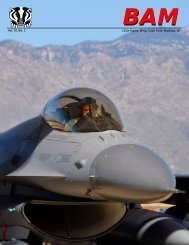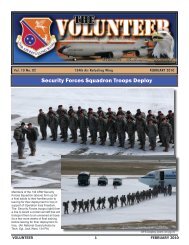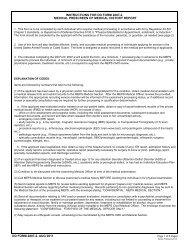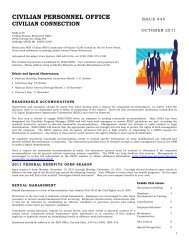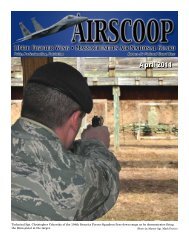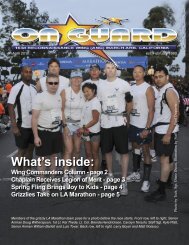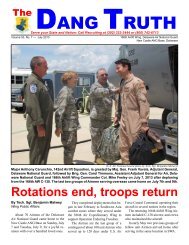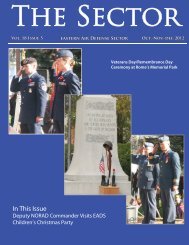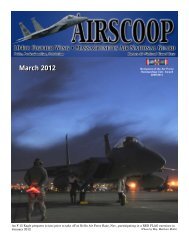Rhode Warrior First Quarter 2013 - 143rd Airlift Wing, Rhode Island ...
Rhode Warrior First Quarter 2013 - 143rd Airlift Wing, Rhode Island ...
Rhode Warrior First Quarter 2013 - 143rd Airlift Wing, Rhode Island ...
- No tags were found...
You also want an ePaper? Increase the reach of your titles
YUMPU automatically turns print PDFs into web optimized ePapers that Google loves.
Active Shooter Threat andResponseBy: Lieutenant Colonel Peter Horne143d AW Anti-terrorism Officer6How’s YOUR Safety CultureUnit Commander?Lt Col Mike Comstock, 143 AW/SEHave you ever seen a news storyabout an overloaded ferrysinking or an overloaded train derailmentkilling hundreds of people? It’susually in a third world country and weask ourselves how the people incharge could have allowed it to happen.Don’t they have any safety regulations? The answeris probably yes, they likely do have safety regulations. Whatthey don’t have is a good safety culture.Good Safety Culture is…the ingrained inclination to follow applicable technical guidanceand proper safety protocols in a given situation.Regulations don’t give a unit a good safety culture.Regulations can be ignored and ultimately forgotten. Cornerscan be cut in the rush to “get ‘er done.” If this is happening inyour unit, you have a poor safety culture and it’s only a matterof time before your ferry sinks or your train derails. Yourmishap may not kill hundreds, but it could kill or seriouslyinjure someone or compromise his ability to work. Theresulting investigation will note the ignorance of regulatoryguidance, the corners cut, and may even find your poor safetyculture culpable in the mishap. It’s a familiar pattern.A good unit safety culture is a function of unit command.Theeffectiveness of a unit safety program is a reflection of theemphasis given it by the unit commander. The commandermust ensure safety is fully integrated within all operations andthat supervisors understand their responsibilities to the safetyprogram. The wing safety office does none of this for you.We’ll support the unit through the Unit Safety Rep and commander,but we can’t give you a good safety culture. This mustbe developed from within over time. If you expect this will be apainful process, that’s probably an indication that your safetyculture isn’t very good and needs to be changed.“Being safe” is no substitute for a good unit safety culture.When I was 17, I thought I was pretty smart with a motto Iinvented to “protect” myself from my own dumb behavior. Mymoronic motto said, “If you’re going to be stupid, be smartabout it.” GENIUS! Okay, so I managed not to get killed orarrested, but I risked everything and was lucky to escapeunscathed. My teenage safety motto sounds ridiculous now,but we essentially do the same thing whenever we think wecan skirt T.O. guidance and safety protocols because we’re“being careful” while doing it. All we’re really doing is foolingourselves into thinking the regs are too strict, as we setthe stage for a future mishap.So unit commander, the safety ball is in your court. Take ahard look at the safety culture in your unit. Do you see aningrained inclination to follow applicable technical guidanceand proper safety protocols or people merely “being safe”?If you see the latter, take no comfort in “so far, so good.”The stage is still being set.Improving Safety Culturewithin Unit CultureMSgt Ken Hupf, 143 AW/SEThe military has a language all itsown, and in the Air NationalGuard we have our own distinctdialect. Over the past few years,we've adopted several new catchphrases to describe changes inthe way we do business. Amongthe most popular is "transformation" and "culture change!"Since these terms may mean different things to different people,I'd like to share with you ideas regarding "safety culture."Within our <strong>Wing</strong>, there is a unique culture built upon history,tradition and core values. But when you look at our units individually,other distinct cultures become apparent. For example,the Maintenance Group has a culture different from theOperations Group. These diverse cultures are a good thing;camaraderie is strengthened through shared experiences andmutual understanding.The great thing about safety is it's relevant in any culture.Unfortunately, safety has often been treated as a regulatoryrequirement rather than a flexible process adapted to a unit'sunique needs. Making safety a fundamental value that's partof every culture will require changing the way we think aboutit, moving from a compliance-based mindset to one focusedon creativity and total team participation. An improved safetyculture means Airmen are keeping risk management in theirthoughts and that helps to reduce injuries, incidents andmishaps!How do we go about making this transformation? Leaders canstart by identifying the strengths, limitations and resourceswithin their units. The next step is to take existing safety programsand tailoring them to their unit's culture. There is no“perfect cure” for the safety issues we see on a daily basis.Our programs must be driven by conditions within the unititself. The challenge our office faces is incorporating theseunique unit cultures into the overall <strong>Wing</strong> safety program.Even the greatest safety program won't be effective if itisn't put into practice every day with buy-in from Airmenat all levels. Change has to come from the top and bottomsimultaneously, with both leaders and subordinates activelyparticipating in the process. The end goal is to have a culturewhere every individual is an owner of their personal safetyand risk management process. The goal is to have peoplemake good choices, work as a team and take care of theirwingman when potentially dangerous situations arise.In these extremely challenging times of doing more withless, now, more than ever, protecting our highly trained team,valuable assets and resources are vital to our mission. Wecan’t do our mission without people, assets or resources.This year has seen an unprecedented level of active shooterincidents in the US. The Active Shooter is considered thegreatest threat in government, military, educational, andmass-gathering public areas such as malls and theaters.The number of attacks demonstrates the need for all personnelto be aware of the potential for similar incidents tooccur locally.There are several types of “Active Shooters”; disgruntledemployee, failed relationship mentally ill, “Terrorist”. Thebottom line is that there is no set profile of an active shooter.There are several warning signs specific to the militaryand include those: involuntarily discharged; awaiting disciplinaryaction; suffering from PTSD; making unsolicitedcomments about violence, firearms or death; served arestraining/no-contact order, made anti-military comments;displays ‘anti-war’ or ‘anti-military’ sentiments, and self-radicalization.If faced with an active shooter scenario, escape is alwaysthe best option. If you can’t escape then go to a securelocation, close/ lock/barricade the doors and windows; turnof lights, radios, televisions, mute cell phones; hide and call911.143d Security Forces members duringan Active Shooter Exercise (providedphoto)143d Security Forces members duringan Active Shooter Exercise (providedphoto)If shooter is in your office remain calm, hide or flee if possible,dial 911 and leave line open. If you commit toattacking the shooter (as a last resort), throw things, useimprovised weapons, yell, and attack with as muchspeed, surprise and violence as you are capable. Whenlaw enforcement arrives: remain calm and follow instructions.When calling 911, advise law enforcement of locationof active shooter(s), description of shooters,number/type of weapons held and number of potentialvictims at the location.The <strong>143rd</strong> <strong>Airlift</strong> <strong>Wing</strong> is dedicated to the safety/securityof all who enter our base. We are making sure that weare prepared for an active shooter scenario by conductingdynamic training and realistic exercises based on currentevents. The key thing to remember is to make a plan asto how you will survive such an event.7






